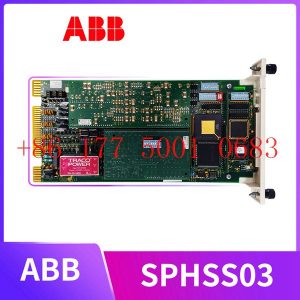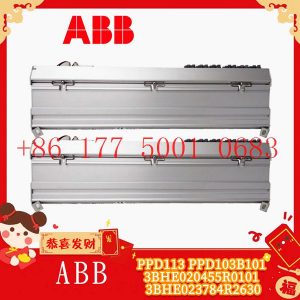Description
hardware flow control. It is an ideal choice in the field of industrial automation.
Why is the industrial Internet inseparable from industrial control?
ABB Global CEO Ulrich Spiesshofer recently accepted an exclusive interview with a reporter from Caijing in New York. He believes that the global manufacturing industry is
undergoing drastic changes. The era of labor arbitrage is over. Labor costs are no longer the focus of competition. The future of manufacturing lies in In factories that are smaller,
closer to consumers, and more agile. Artificial intelligence ( AI ) is the most important technology shaping the future of manufacturing. Currently, AI technology is mainly used in the
consumer field, but its large-scale application in the industrial field and among enterprises is more critical.
Digital transformation has been a keyword for global manufacturing giants in the past two years, and the industrial Internet is the implementation form of digital transformation.
General Electric (GE), Siemens and ABB are all leaders in this regard . Spiesshofer believes that GE”s industrial Internet only collects data and analyzes but cannot control it.
As the world”s two largest industrial automation suppliers, ABB and Siemens have the ability to control equipment, which is a significant difference from GE.
ABB is headquartered in Zurich, Switzerland. Its history can be traced back to the 1880s. It started from the original electrical manufacturing business and has developed into an international manufacturing
giant including electrical products, robotics and motion control, industrial automation and power grid. In 2017, ABB”s revenue was US$34.3 billion, ranking 341st among the
Fortune 500 companies. Spiesshofer has served as CEO for nearly five years since taking office in September 2013.
Below are the details of the interview.
The era of labor arbitrage is over
Caijing: Is 2018 a good year for the manufacturing industry?
Spiesshofer: From a global perspective, GDP is growing and consumption is also growing. Overall positive.
Caijing: What crucial changes are taking place in the manufacturing industry?
Spiesshofer: The jobs of the future will be different from the jobs of the past. In the Middle Ages, craftsmen moved between villages, taking their tools with them to work where
there was demand; later we invented factories, integrated supply and demand, and invented logistics; later people realized that there was labor arbitrage (Labor Arbitrage, Refers to
the existence of moving industries that have lost technological advantages and technical barriers to areas with low labor prices to increase profits by reducing labor costs), so we place
factories in emerging countries to benefit from labor arbitrage.
Now, with the development of modern automation and robotics, we can break this picture and bring value addition closer to demand. I think the future of manufacturing is
in factories that are smaller, closer to consumers, and more agile. I believe that the global logistics chain will also be reduced in the future because we will produce products closer to consumers.
The era of labor arbitrage shaping the global manufacturing landscape will be over because we can offset this arbitrage.
Recently we opened a new factory in Germany. Due to the adoption of intelligent automation technology, its unit cost is exactly the same as that of the best factories in
China. So I think the local market will be repositioned in the future, and the positioning of competitiveness will also change from just considering costs to focusing more on technology and value.
Caijing: Many people are complaining that automation has caused people to lose their jobs, and artificial intelligence technology has made the complaints louder
. But these new technologies are also creating new jobs. How do you see the relationship between the two?
Spiesshofer: In 1990, one-third of the world”s population lived below the extreme poverty line. Today, only 8% rely on technology. In fact, countries with the
highest robot densities, such as Germany, South Korea, Singapore, and Japan, also have the lowest unemployment rates. Robots combined with educated people can create prosperity, produce more
affordable goods, and lead to economic growth. Government, education and business need to work together to keep up with the changing world.
Clearly, millions of jobs are disappearing, but millions of new ones are being created. Taking our own business as an example, we used to have many
employees doing metal casting and forging work, but now these tasks are automated. But now we have more employees working in the service industry, developing apps, and working with customers.
So I think we should not be afraid of change, but should lead our employees to manage change and promote change. If we succeed, global employment will eventually grow.
https://www.xmamazon.com
https://www.xmamazon.com
https://www.plcdcs.com/
www.module-plc.com/
https://www.ymgk.com
8280-418 single-enginefor boatscontrol unit
8280-417 DSLC/MSLC Gateway Controller
8280-416 DSLC/MSLC Gateway Control
8280-415 Governor Digital Speed Controller
8280-414 Shared Digital Speed Controller
8280-413 digital speed control
8280-413 woodward controller
8280-412 723PLUS Controller
8280-411 Digital Controllers for the 723Plus Series
8280-410 723PLUS Digital Industrial Speed Controller
8280-339 Woodward 723PLUS
8280-338 Low voltage controller
8280-219 woodward speed controller
8280-208 723 Digital Marine Speed Control
8280-207 woodward governor
8280-206 723 Speed Control/Generation
8280-1173 digitalfor boatswith speed control
8280-1129 digital governor
8280-1109 723PLUS Digital Marine Speed Control Model
8280-1099 723PLUS Standard Generator Control
8280-1076 load sharing control
8280-1056 Digital control unit for redundant load distribution
8280-1042 Single Engine Digital Speed Controller
8280-1009 Numerical Control Model
8280-1001 723PLUS Digital Controller
8262-092 digital control
8237-1278 versatile Woodward DSLC/MSLC Gateway Control
8237-1277 gateway controller
8230-3012 723PLUS Generator Control
8230-3011 WOODWARD digital controller
9907-171 operator control panel
9907-170 Woodward 505E Microprocessor Based Control Unit
9907-169 Digital Control of Turbines
9907-166 Woodward 505E 32-bit microprocessor
9907-167 505E Series Digital Control Equipment
9907-165 32-bit microcontroller
8200-1302 505 Digital Governor
9907-1183 32-bit microcontroller
8200-1300 Gas turbines provide digital control
9907-164 505 and 505E Governor Control Units
9907-163 Governor Control Unit
9907-162 Controls for 505 and 505E Models
FBM24 PM900HT Contact/DC Input
FBM22 PM900HS Auto/Manual Station
FBM21 PM700TW 240 Vac Input Expander
FBM20 PM700QV 240 Vac input
FBM18 PM400YV Smart Transmitter I/O
FBM17 PM400YT 0-10 Vdc, Contact/DC I/O









Reviews
There are no reviews yet.